The digital drawdown call option with qualifying period pays a unit amount when the drawdown period reaches
Question:
The digital drawdown call option with qualifying period pays a unit amount when the drawdown period reaches one unit of time, if this happens before fixed maturity \(T\), but only if the size of drawdown at this stopping time is larger than a prespecified \(K\). This provides an insurance against a prolonged drawdown, if the drawdown amount is large. Specifically, the digital drawdown call option is priced as
\[\mathbb{E}^{*}\left[\mathrm{e}^{-r \tau} \mathbb{1}_{\{\tau \leqslant T\}} \mathbb{1}_{\left\{M_{0}^{\tau}-S_{\tau} \geqslant Kight\}}ight],\]
where \(M_{0}^{t}:=\operatorname{Max}_{u \in[0, t]} S_{u}, U_{t}:=t-\operatorname{Sup}\left\{0 \leqslant u \leqslant t: M_{0}^{t}=S_{u}ight\}\), and \(\tau:=\inf \left\{t \in \mathbb{R}_{+}ight.\): \(\left.U_{t}=1ight\}\). Write the price of the drawdown option as a triple integral using the joint probability density function \(f_{\left(\tau, S_{\tau}, M_{\tau}ight)}(t, x, y)\) of \(\left(\tau, S_{\tau}, M_{\tau}ight)\) under the risk-neutral probability measure \(\mathbb{P}^{*}\).
Step by Step Answer:

Introduction To Stochastic Finance With Market Examples
ISBN: 9781032288277
2nd Edition
Authors: Nicolas Privault





